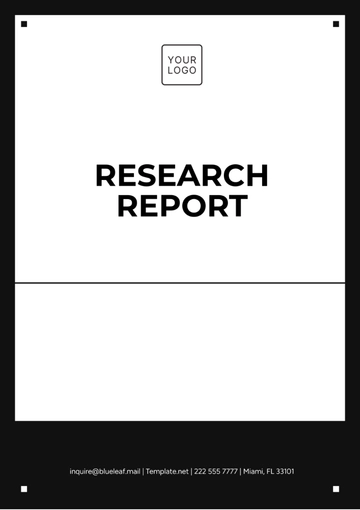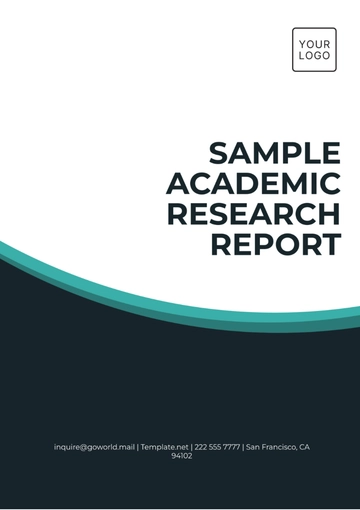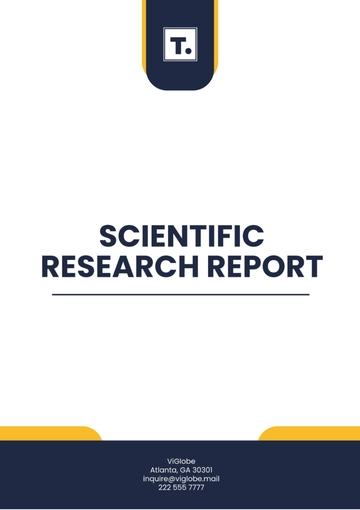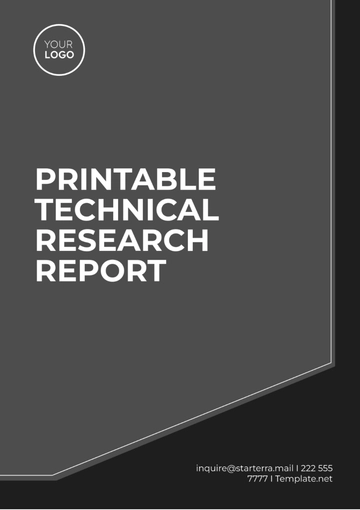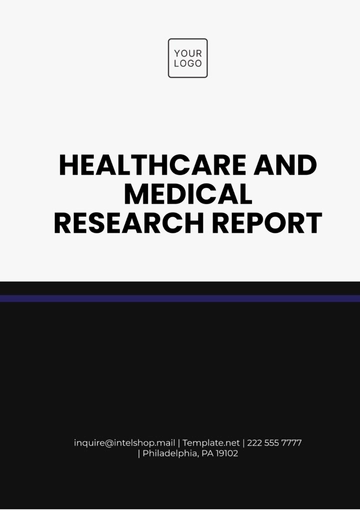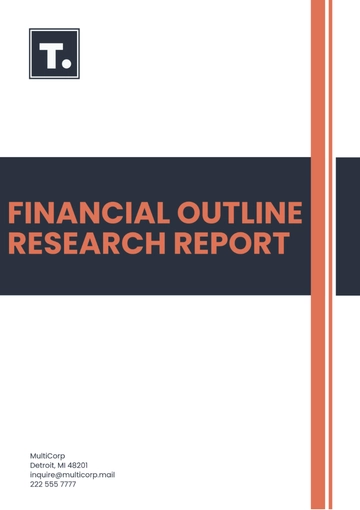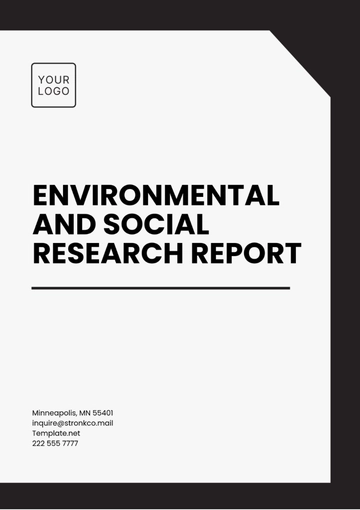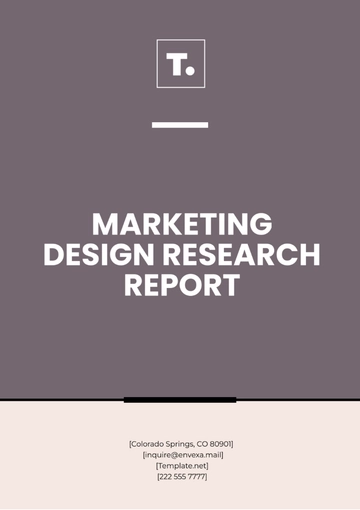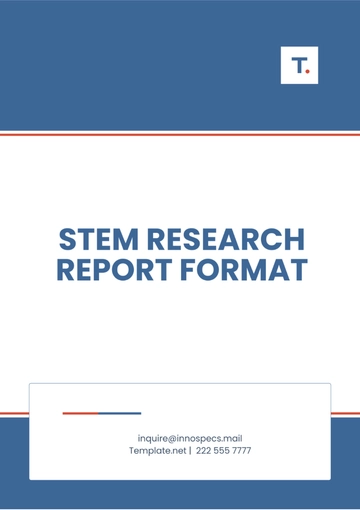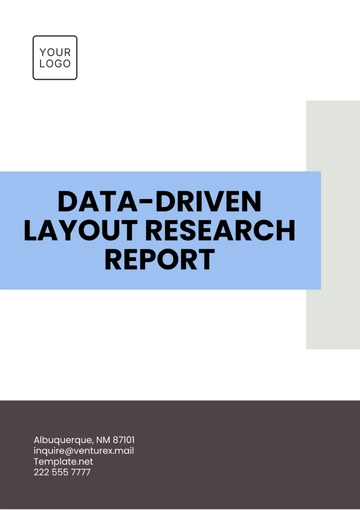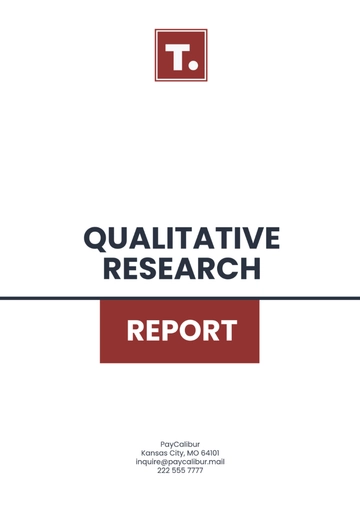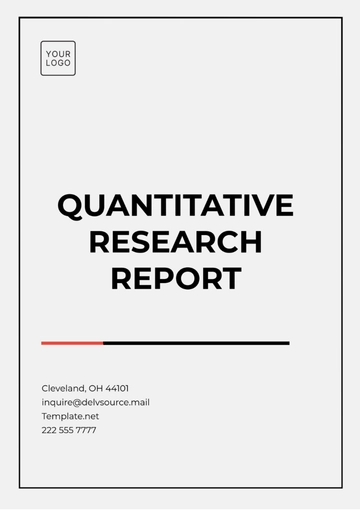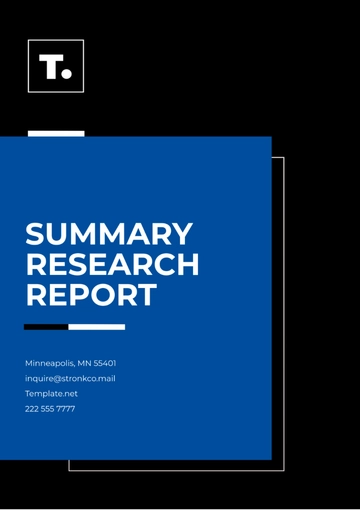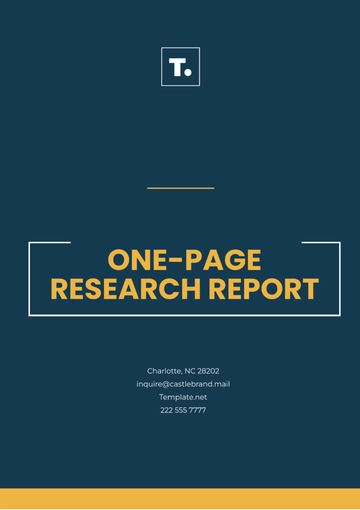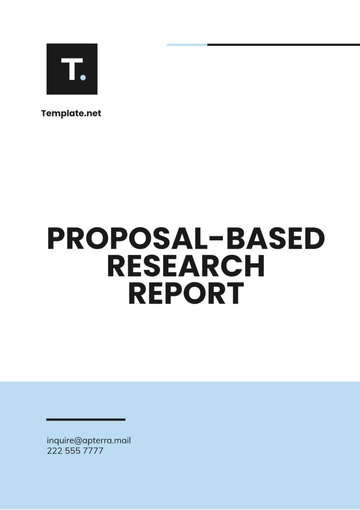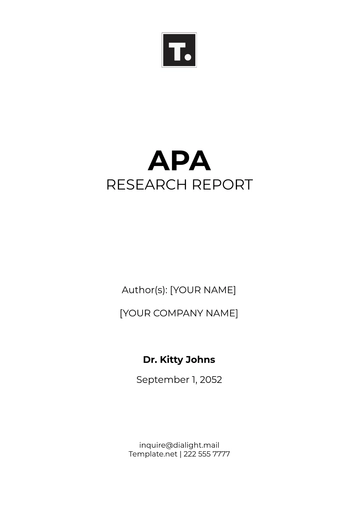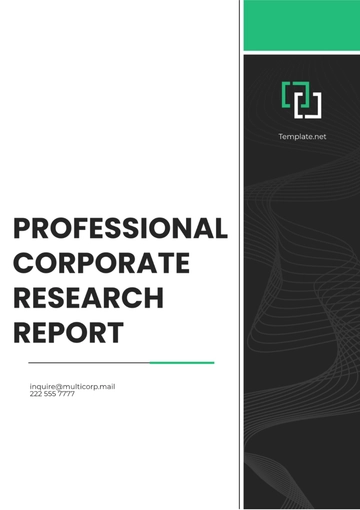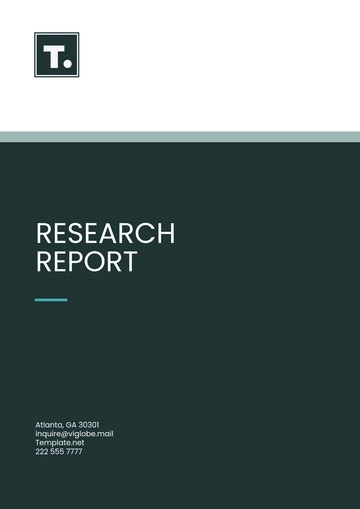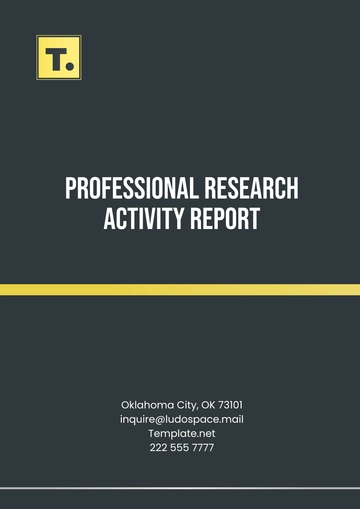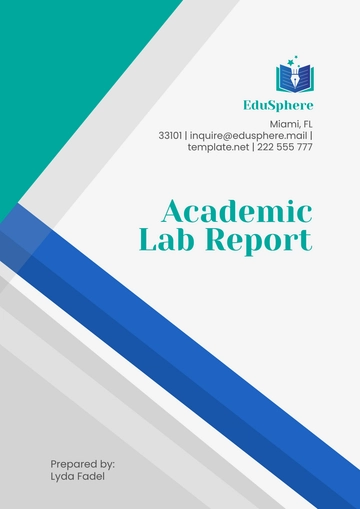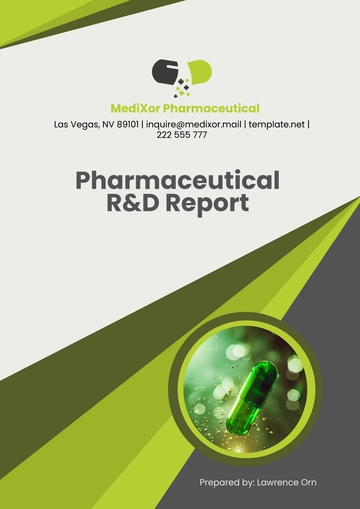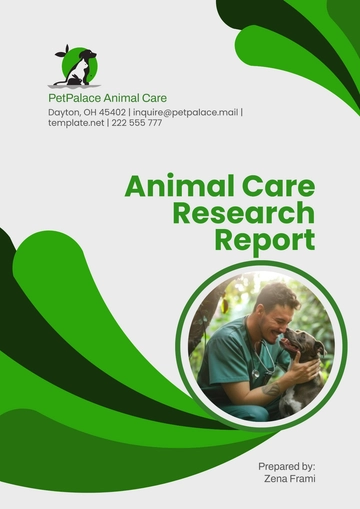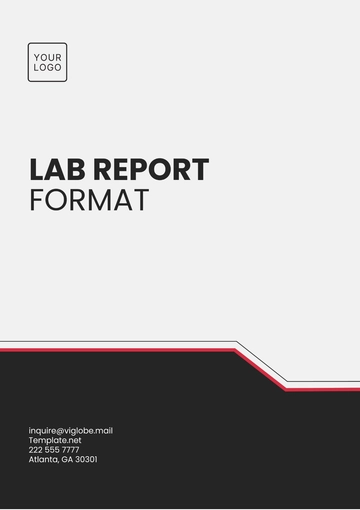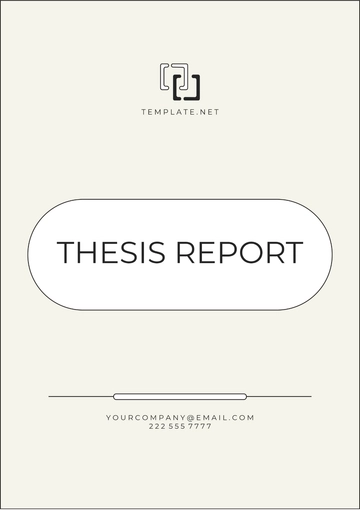Free Pharmaceutical R&D Report
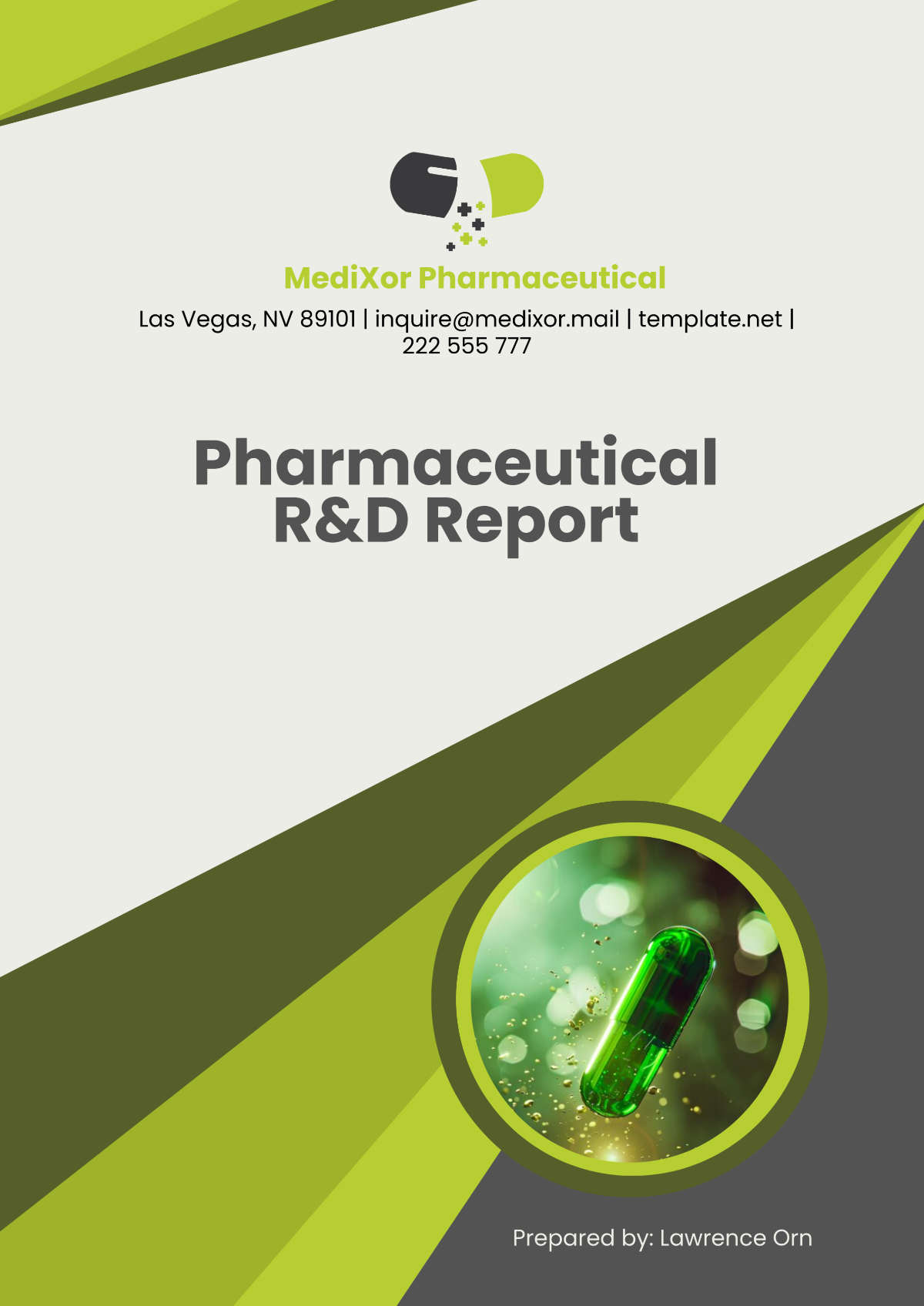
I. Introduction
The pharmaceutical industry is a cornerstone of the global healthcare sector, dedicated to the discovery, development, and delivery of safe and effective medications that improve quality of life and address a wide array of health challenges. At [Your Company Name], we are committed to advancing pharmaceutical research and development (R&D) through cutting-edge innovation, robust scientific methodologies, and adherence to stringent regulatory frameworks. Our work not only impacts individual patients but also shapes public health strategies and outcomes on a global scale.
This report offers an in-depth analysis of the pharmaceutical R&D landscape, highlighting the key processes, emerging trends, and persistent challenges. From early-stage drug discovery to clinical trials and regulatory approval, the journey to bring new therapies to market is complex and requires significant investment, collaboration, and scientific rigor. At [Your Company Name], we aim to lead the way in developing solutions that address unmet medical needs and set new benchmarks in pharmaceutical excellence.
II. Pharmaceutical R&D Process
A. Drug Discovery
Drug discovery involves identifying new candidate medications through various approaches such as high-throughput screening, bioprospecting, computational drug design, and more. It is the first stage in the R&D process and is crucial for finding potential treatments for various diseases.
High-throughput screening
Genomics and proteomics approaches
Computational drug design
B. Preclinical Research
Once potential compounds are identified, they undergo preclinical research to establish safety and efficacy profiles before testing in humans. This stage involves laboratory and animal studies to gather data on pharmacodynamics, pharmacokinetics, and toxicology.
C. Clinical Trials
Clinical trials are conducted in multiple phases to ensure the safety and efficacy of new drugs. These trials are regulated by international guidelines to protect participants and ensure reliable results.
Phase | Purpose | Sample Size |
|---|---|---|
Phase I | Assess safety and dosage | 20-100 participants |
Phase II | Evaluate efficacy and side effects | 100-300 participants |
Phase III | Confirm effectiveness, monitor adverse reactions | 1,000-3,000 participants |
D. Regulatory Approval
Following successful clinical trials, companies submit a New Drug Application (NDA) or a Biologics License Application (BLA) to regulatory authorities such as the FDA or EMA. The approval process involves a thorough review of all data concerning the drug’s safety and effectiveness.
III. Key Challenges in Pharmaceutical R&D
A. High Costs and Long Timelines
Developing a new drug is a resource-intensive endeavor, with costs often surpassing billions of dollars and timelines stretching over 10–15 years from initial discovery to market approval. Several factors contribute to these high costs and extended durations:
Preclinical Research: Early-stage development involves significant investment in laboratory studies, animal testing, and optimization of drug candidates, all of which require advanced technology and skilled personnel. These steps are necessary to establish preliminary efficacy and safety profiles.
Clinical Trials: The most expensive and time-consuming phase, clinical trials, involve testing in human populations across multiple stages (Phases I–III). These trials must meet stringent requirements set by regulatory agencies such as the FDA, ensuring robust data collection on safety, efficacy, and dosing.
Regulatory Compliance: Extensive documentation and adherence to regulatory guidelines, including Good Laboratory Practice (GLP) and Good Clinical Practice (GCP), add to the complexity and cost.
Risk of Failure: Despite significant investment, only a small fraction of drug candidates achieve market approval, increasing overall costs.
B. Regulatory Hurdles
Navigating the intricate regulatory landscape is one of the most significant challenges in pharmaceutical R&D. Companies like [Your Company Name] must comply with a wide array of laws, standards, and guidelines, which vary across countries and regions. These regulations are designed to ensure the safety, efficacy, and quality of drugs but often introduce additional complexities to the development process.
Global Regulatory Variability: Each country has its own regulatory authority, such as the FDA in the U.S., EMA in the EU, and PMDA in Japan, each with distinct requirements for drug approval. Harmonizing processes to meet these standards demands significant resources and expertise.
Evolving Standards: Regulatory guidelines continuously evolve to address emerging scientific insights, new technologies, and safety concerns. Staying abreast of these changes requires dedicated teams and adaptive strategies.
Documentation and Compliance: Comprehensive data submission, including clinical trial results, manufacturing details, and safety reports, is required to meet Good Manufacturing Practice (GMP) and Good Clinical Practice (GCP) standards. This documentation must be precise and exhaustive, increasing the workload.
Approval Timelines: Regulatory review and approval processes can be lengthy and unpredictable, delaying market entry for potentially life-saving drugs.
C. Intellectual Property Issues
Intellectual property (IP) rights play a pivotal role in driving pharmaceutical innovation by granting companies the exclusive ability to recoup their investments in research and development. However, these protections also spark significant ethical debates, particularly regarding equitable access to life-saving medications.
Incentives for Innovation: Patents provide a temporary monopoly, typically lasting 20 years from the filing date, allowing companies like [Your Company Name] to recover R&D costs and fund future innovation. Without IP protection, competitors could replicate and market drugs without bearing the associated development expenses, disincentivizing innovation.
Ethical Concerns: The exclusivity granted by patents often leads to higher drug prices, limiting access for underserved populations, especially in low- and middle-income countries. This creates a tension between rewarding innovation and ensuring public health equity.
Patent Challenges: Patent disputes, such as claims of "evergreening" (making minor modifications to extend patent life), can further complicate the landscape. Such practices are often criticized for delaying the entry of more affordable generics into the market.
Global IP Variations: Differences in IP laws across countries add complexity for multinational pharmaceutical companies, requiring strategies that adapt to diverse legal environments while ensuring global access.
IV. Innovations in Pharmaceutical R&D
A. Biotechnology and Personalized Medicine
Biotechnology is revolutionizing pharmaceutical R&D by enabling breakthroughs in personalized medicine, an approach that customizes treatments based on an individual’s unique genetic profile, lifestyle, and environment. This innovation has transformed how diseases are diagnosed, treated, and even prevented, offering the potential for more effective and safer therapies.
Advances in Genomics: The rapid sequencing of the human genome has paved the way for understanding genetic factors underlying diseases. This knowledge allows for the identification of biomarkers that guide the development of targeted therapies, such as monoclonal antibodies or gene therapies.
Tailored Treatments: Personalized medicine moves away from the "one-size-fits-all" model by creating treatments that align with a patient’s genetic predispositions. For instance, in oncology, treatments like CAR-T cell therapy are designed to attack specific cancer cells, reducing damage to healthy tissues.
Improved Outcomes: By tailoring drugs to genetic profiles, personalized medicine enhances efficacy and minimizes adverse effects. For example, pharmacogenomics enables clinicians to prescribe medications at optimal doses based on how a patient’s body metabolizes certain drugs.
Biologics and Biosimilars: Innovations in biotechnology have also led to the rise of biologics, complex drugs derived from living organisms, and biosimilars, which provide more affordable alternatives without compromising quality or efficacy.
B. Artificial Intelligence and Machine Learning
Artificial intelligence (AI) and machine learning (ML) are reshaping the pharmaceutical R&D landscape by accelerating processes, enhancing decision-making, and reducing costs. These advanced technologies enable pharmaceutical companies like [Your Company Name] to optimize drug discovery, clinical trials, and personalized patient care strategies.
Accelerated Drug Discovery: AI-powered platforms can analyze vast datasets to identify promising drug candidates more quickly than traditional methods. By simulating molecular interactions, these tools help predict the efficacy and safety of compounds, reducing the time required for preclinical research.
Optimized Clinical Trials: AI and ML streamline patient recruitment by identifying individuals most likely to benefit from a treatment based on genetic and demographic data. Additionally, algorithms can monitor trial data in real-time, improving safety oversight and adjusting protocols as needed.
Predictive Analytics: Machine learning models predict clinical outcomes by analyzing data from past trials and patient responses. This predictive capability allows researchers to prioritize drug candidates with the highest likelihood of success, saving valuable resources.
Personalized Treatment Plans: AI-driven tools aid in developing individualized care strategies by analyzing patient-specific factors, such as genetic information and medical history. This ensures that therapies are tailored to maximize effectiveness while minimizing side effects.
Operational Efficiency: Beyond discovery and trials, AI optimizes supply chain management, regulatory compliance processes, and post-market surveillance, ensuring efficiency across the pharmaceutical lifecycle.
C. Collaborative Research Models
Collaborative research models are becoming integral to pharmaceutical R&D, enabling organizations to address complex scientific challenges by pooling resources, expertise, and technology. At [Your Company Name], we recognize the value of these partnerships in accelerating innovation and improving patient outcomes.
Academic Partnerships: Collaborating with universities and research institutions provides access to groundbreaking discoveries and specialized knowledge. These alliances often focus on early-stage research, identifying novel drug targets or exploring cutting-edge scientific concepts.
Biotech Collaborations: Partnering with biotechnology firms allows pharmaceutical companies to harness innovative platforms, such as gene editing and biologics development. Biotech firms often excel in agility and innovation, complementing the resources and scale of larger pharmaceutical companies.
Government and Public-Private Initiatives: Governments and international organizations frequently support research initiatives, offering funding, regulatory guidance, and infrastructure. Examples include partnerships formed during the COVID-19 pandemic to expedite vaccine development.
Consortia and Shared Databases: Collaborative consortia, where multiple companies and institutions share pre-competitive data, foster innovation while reducing duplication of effort. Shared databases, like genomic libraries, accelerate discovery by providing a wealth of accessible data.
Patient-Centric Collaborations: Engaging with patient advocacy groups ensures research is aligned with patient needs and accelerates recruitment for clinical trials, ultimately leading to therapies that better address real-world challenges.
V. Conclusion
Pharmaceutical R&D is a dynamic and ever-evolving domain, marked by its dual nature of immense challenges and transformative innovations. High costs, regulatory complexities, and ethical considerations continue to pose significant hurdles, yet advancements in biotechnology, artificial intelligence, and collaborative research models are reshaping the industry. As we move forward, integrating cutting-edge technologies and fostering strategic partnerships will be pivotal in overcoming these barriers. At [Your Company Name], we are committed to leading this evolution, driving the development of life-saving medications with efficiency, precision, and a patient-centered approach. Together, we can shape a healthier, more innovative future for global healthcare.
- 100% Customizable, free editor
- Access 1 Million+ Templates, photo’s & graphics
- Download or share as a template
- Click and replace photos, graphics, text, backgrounds
- Resize, crop, AI write & more
- Access advanced editor
Streamline reporting with the Pharmaceutical R&D Report Template from Template.net. Fully editable and customizable, this template allows you to document research and development findings in a clear and professional format. Easily editable in our Ai Editor Tool, it ensures an organized approach to presenting R&D results. Simplify your reporting process with this template.
You may also like
- Sales Report
- Daily Report
- Project Report
- Business Report
- Weekly Report
- Incident Report
- Annual Report
- Report Layout
- Report Design
- Progress Report
- Marketing Report
- Company Report
- Monthly Report
- Audit Report
- Status Report
- School Report
- Reports Hr
- Management Report
- Project Status Report
- Handover Report
- Health And Safety Report
- Restaurant Report
- Construction Report
- Research Report
- Evaluation Report
- Investigation Report
- Employee Report
- Advertising Report
- Weekly Status Report
- Project Management Report
- Finance Report
- Service Report
- Technical Report
- Meeting Report
- Quarterly Report
- Inspection Report
- Medical Report
- Test Report
- Summary Report
- Inventory Report
- Valuation Report
- Operations Report
- Payroll Report
- Training Report
- Job Report
- Case Report
- Performance Report
- Board Report
- Internal Audit Report
- Student Report
- Monthly Management Report
- Small Business Report
- Accident Report
- Call Center Report
- Activity Report
- IT and Software Report
- Internship Report
- Visit Report
- Product Report
- Book Report
- Property Report
- Recruitment Report
- University Report
- Event Report
- SEO Report
- Conference Report
- Narrative Report
- Nursing Home Report
- Preschool Report
- Call Report
- Customer Report
- Employee Incident Report
- Accomplishment Report
- Social Media Report
- Work From Home Report
- Security Report
- Damage Report
- Quality Report
- Internal Report
- Nurse Report
- Real Estate Report
- Hotel Report
- Equipment Report
- Credit Report
- Field Report
- Non Profit Report
- Maintenance Report
- News Report
- Survey Report
- Executive Report
- Law Firm Report
- Advertising Agency Report
- Interior Design Report
- Travel Agency Report
- Stock Report
- Salon Report
- Bug Report
- Workplace Report
- Action Report
- Investor Report
- Cleaning Services Report
- Consulting Report
- Freelancer Report
- Site Visit Report
- Trip Report
- Classroom Observation Report
- Vehicle Report
- Final Report
- Software Report
